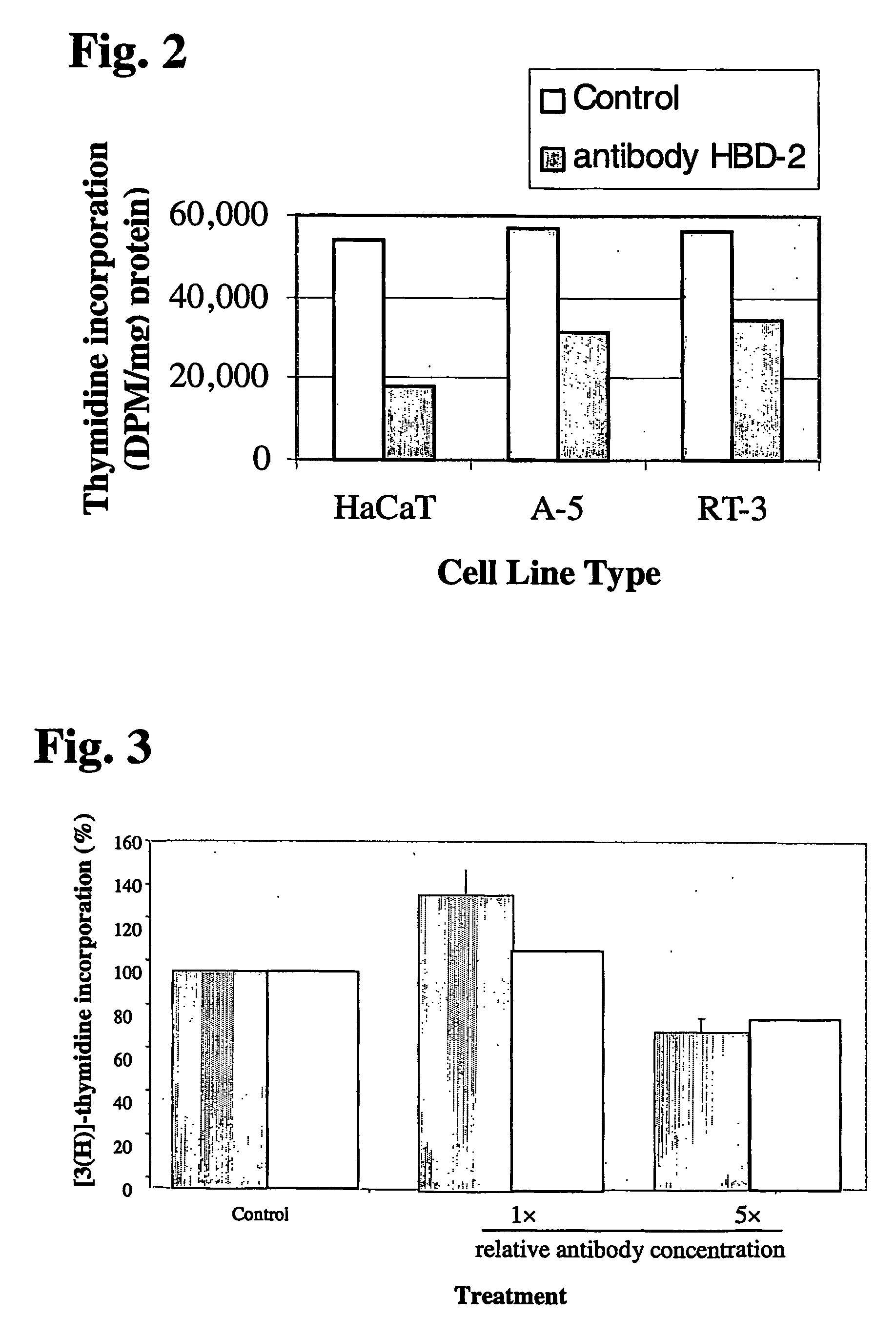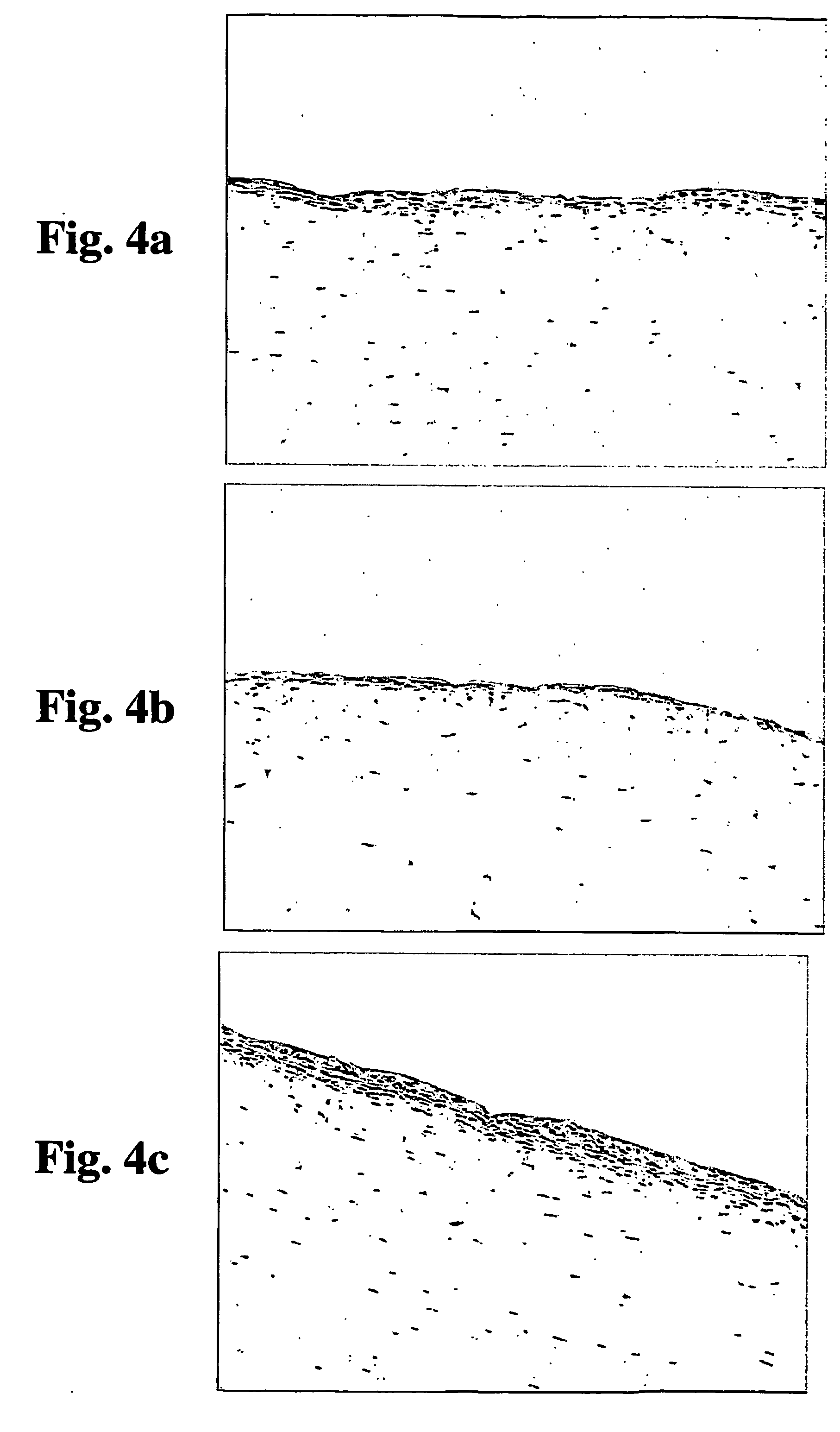Disease treatment via antimicrobial peptide inhibitors
a technology of antimicrobial peptides and peptides, which is applied in the direction of peptides, immunological disorders, drug compositions, etc., can solve the problems of no satisfactory treatment methods available, so as to achieve the effect of decreasing the level/activity of amps
- Summary
- Abstract
- Description
- Claims
- Application Information
AI Technical Summary
Benefits of technology
Problems solved by technology
Method used
Image
Examples
example 1
Use of Anti-AMP Antibodies for Inhibition of Carcinoma Cell Proliferation and Loss of Substrate-Attachment
Optimal Treatment Method for Carcinomas Such as Metastatic Malignant Skin Carcinoma
[0404] Background: No optimal therapy exists for treatment of metastatic malignant carcinomas, such as metastatic malignant skin carcinoma. An optimal strategy for treating such diseases would be to identify factors involved in inducing carcinoma cell growth and loss of substrate attachment and identifying compounds capable of inhibiting such factors so as to inhibit such growth and loss of substrate attachment. While reducing the present invention to practice, a significant role for AMPs in driving carcinoma proliferation and loss of substrate attachment was identified, and the capacity of anti-AMP antibodies to inhibit such growth and loss of substrate attachment so as to enable optimal treatment of carcinoma, including malignant metastatic skin carcinoma was demonstrated, as described below, ...
example 2
Use of Anti-AMP Antibodies for Regulation of Skin Cell Proliferation
Optimal Treatment Method for Diseases Requiring Therapeutic Regulation of Skin Growth, Such as Skin Wounds, Burns, and Skin Tumors
[0413] Background: No optimal therapy exists for treatment of various diseases, such as skin wounds and burns, requiring therapeutic regulation of skin growth. An optimal strategy for treating such diseases would be to inhibit the activity of factors involved in preventing skin growth. While reducing the present invention to practice, the capacity of specific concentrations of anti-AMP antibodies to upregulate or downregulate skin growth so as to enable optimal treatment of diseases, such as skin wounds and burns, was demonstrated, as described below, thereby overcoming the limitations of the prior art.
[0414] Materials and Methods:
[0415] Antibodies: The anti-human beta-defensin-2 antibody used was polyclonal goat anti-human beta-defensin-2 antibody obtained by immunization with greate...
example 3
Use of Anti-AMP Antibodies for Optimal Treatment of Diseases, Such as Psoriasis, which are Associated with Inflammation, Autoimmunity and / or Skin Cell / Tissue Proliferation / Differentiation Imbalance
[0420] Background: Diseases associated with inflammation, autoimmunity and / or skin cell / tissue proliferation / differentiation imbalance include numerous diseases, such as psoriasis and dandruff, for which no optimal therapy exists. Angiogenesis and epithelialization common in psoriatic skin is enhanced by AMPs such as LL-37 (Koczulla, R. et al., 2003. J. Clin. Invest 111:1665-1672; Heilborn, J D. et al., 2003. J Invest Dermatol 120:379-389). An optimal strategy for treating such diseases would be to identify factors involved in dysregulation of skin cell / tissue proliferation / differentiation, and to use compounds capable of inhibiting the activity of such factors to treat such diseases. Such compounds, however, have not been identified. AMPs / AMLs involved in psoriasis include psoriasin, def...
PUM
 Login to View More
Login to View More Abstract
Description
Claims
Application Information
 Login to View More
Login to View More - R&D
- Intellectual Property
- Life Sciences
- Materials
- Tech Scout
- Unparalleled Data Quality
- Higher Quality Content
- 60% Fewer Hallucinations
Browse by: Latest US Patents, China's latest patents, Technical Efficacy Thesaurus, Application Domain, Technology Topic, Popular Technical Reports.
© 2025 PatSnap. All rights reserved.Legal|Privacy policy|Modern Slavery Act Transparency Statement|Sitemap|About US| Contact US: help@patsnap.com



